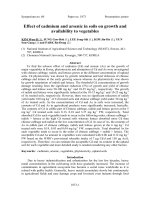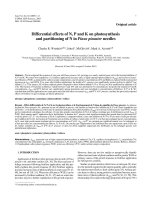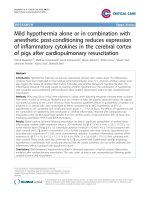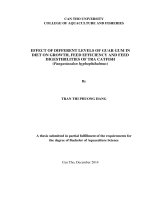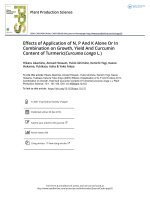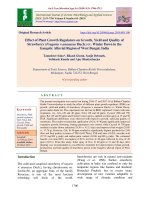Effects of application of n p and k alone or in combination on growth yield and curcumin content of turmeric curcuma longa l
Bạn đang xem bản rút gọn của tài liệu. Xem và tải ngay bản đầy đủ của tài liệu tại đây (460.72 KB, 5 trang )
Plant Production Science
ISSN: 1343-943X (Print) 1349-1008 (Online) Journal homepage: />
Effects of Application of N, P And K Alone Or In
Combination on Growth, Yield And Curcumin
Content of Turmeric(Curcuma Longa L.)
Hikaru Akamine, Amzad Hossain, Yukio Ishimine, Kenichi Yogi, Kazuo
Hokama, Yukikazu Iraha & Yoko Aniya
To cite this article: Hikaru Akamine, Amzad Hossain, Yukio Ishimine, Kenichi Yogi, Kazuo
Hokama, Yukikazu Iraha & Yoko Aniya (2007) Effects of Application of N, P And K Alone Or In
Combination on Growth, Yield And Curcumin Content of Turmeric(Curcuma�Longa L.), Plant
Production Science, 10:1, 151-154, DOI: 10.1626/pps.10.151
To link to this article: />
© 2007 Crop Science Society of Japan
Published online: 03 Dec 2015.
Submit your article to this journal
Article views: 666
Citing articles: 17 View citing articles
Full Terms & Conditions of access and use can be found at
/>
Plant Prod. Sci. 10(1) : 151 ― 154 (2007)
【Short Report】
Effects of Application of N, P and K Alone or in Combination
on Growth, Yield and Curcumin Content of Turmeric
(Curcuma longa L.)
Hikaru Akamine1, Md. Amzad Hossain1, Yukio Ishimine1, Kenichi Yogi2, Kazuo Hokama2,
Yukikazu Iraha2 and Yoko Aniya3
(1Subtropical Field Science Center, Faculty of Agriculture, University of the Ryukyus, Nishihara Cho, Okinawa 903-0213, Japan;
2
Okinawa Agricultural Experiment Station, Naha Shi, Okinawa 903-0814, Japan;
3
Graduate School of Medicine, University of the Ryukyus, Nishihara Cho, Okinawa 903-0215, Japan)
Key words : Chemical fertilizer, Medicinal plant, Root crop, Turmeric growth and yield.
Crops respond differently to different fertilizer
elements, and proper fertilizer management for a
plant species is important for increasing yield and
quality. Nitrogen (N), phosphorus (P) and potassium
(K) are the three major nutrients, which individually
and/or together maintain growth, yield and quality of
plants (Mazid, 1993; Ivonyi et al., 1997). N is involved
in chlorophyll formation, and it influences stomatal
conductance and photosynthetic efficiency (Mazid,
1993; Ivonyi et al., 1997). N is responsible for 26-41%
of crop yields (Mazid, 1993; Maier et al., 1994, 1996).
K plays catalytic roles in the plant rather than
becoming an integral part of plant components. It
regulates the permeability of cell walls and activities
of various mineral elements as well as neutralizing
physiologically important organic acids. Plants with
an inadequate supply of K show poor fruit or seed
formation, yellowing of the leaves, poor growth, and
low resistance to coldness and drought (Oya, 1972).
A sufficient supply of K promotes N uptake efficiency
of plants due to its stimulant effect on plant growth. P
indirectly promotes plant growth and absorption of K
as well as other nutrients (Oya, 1972).
Turmeric (Curcuma longa L.) is used in many
countries as a spice and cosmetic (Ishimine et al.,
2003; Hossain et al., 2005a, b). It is now a popular
medicinal plant worldwide. Curcumin the main
component of turmeric functions as a medicine with
anti-inflammatory, anti-mutagenic, anti-carcinogenic,
anti-tumor, anti-bacterial, anti-oxidant, anti-fungal,
anti-parasitic and detox properties (Hermann and
Martin, 1991; Osawa et al., 1995; Sugiyama et al.,
1996; Nakamura et al., 1998). The efficacy of C. longa
found on a specific disease varies with the studies, and
in some cases no efficacy was found (Hermann and
Martin, 1991; Osawa et al., 1995; Sugiyama et al., 1996;
Nakamura et al., 1998). Such differences may be due
to variation in the curcumin content which is assumed
to depend on the fertilizer elements.
Turmeric is a horticultural crop demanding heavy
fertilization for increasing yield and quality (Reddy
and Rao, 1978; Govind et al., 1990; Yamgar et al.,
2001). We reviewed several papers and found that the
chemical fertilizers affect growth, yield and quality of
turmeric variously, and the effects of N, P and K alone
or in combination are not clear, because farmyard
manure was used together and some experiments did
not include control treatment (Reddy and Rao, 1978;
Govind et al., 1990; Yamgar et al., 2001; Behura, 2001).
Turmeric is commercially cultivated in Okinawa,
but yield per unit area and curcumin content are
very poor, because fertilizer management is not well
known to the farmers (Hossain and Ishimine, 2005).
In previous studies, we evaluated planting depth,
time, pattern, seed size and soil types on growth and
yield of turmeric in Okinawa (Ishimine et al., 2003,
2004; Hossain et al., 2005a, b; Hossain and Isimine,
2005). The present study was undertaken to evaluate
the effects of N, P and K alone or in combination on
growth, yield and curcumin content of turmeric.
Materials and Methods
1. Turmeric cultivation
The glasshouse experiment was conducted using
dark-red soil (Shimajiri maaji) at the Subtropical
Field Science Center of the University of the Ryukyus,
from April 15, 2003 to January 14, 2004. Wagner pots
(size 0.05 m2) were filled with 10 kg of air-dried soil
each pot. Table 1 shows the chemical properties of
soil (subsoil). No organic fertilizer was added to soil
for determining actual effects of chemical fertilizers
on growth, yield and curcumin content of turmeric.
Received 17 October 2005. Accepted 19 July 2006. Corresponding author: Y. Ishimine (, fax +81-98-895-8741).
152
Plant Production Science Vol.10, 2007
Table 1. Chemical properties of dark-red soil in Okinawa, Japan.
Na
mg kg-1
K
mg kg-1
Ca
mg kg-1
Mg
mg kg-1
Al
mg kg-1
Fe
mg kg-1
P
mg kg-1
S
mg kg-1
NO3-N
mg kg-1
NH4-N
mg kg
mg kg
soil
soil
soil
soil
soil
soil
soil
soil
soil
soil
soil
30.52
6.39
24.98
5.37
0.54
0.25
0.52
36.68
680
590
2300
-1
C
pH
-1
(H2O)
5.26
Data are means of 3 replications. Data were recorded on the dry weight basis.
Table 2. Effects of N, P and K applied alone or in combination on plant height, leaf number, tiller number, shoot (dry
weight), yield (rhizome dry weight) and curcumin content of turmeric.
Fertilizer
treatments
Plant height
(cm)
Leaf
(no. plant-1)
Tiller
(no. plant-1 )
Shoot
(g plant-1)
Yield
(g plant-1)
Control
N
50.2 ± 3.2d
112.8 ± 5.7c
41.2 ± 3.9e
9.8 ± 2.7d
16.0 ± 2.3c
9.6 ± 2.7d
1.6 ± 0.5d
2.6 ± 0.5c
1.6 ± 0.5d
13.6 ± 2.2d
60.4 ± 6.7c
13.5 ± 1.9d
17.5 ± 1.9e
55.1 ± 2.1d
0.15 ± 0.01de
0.14 ± 0.01e
44.8 ± 4.2de
121.4 ± 4.0b
149.4 ± 4.1a
38 ± 2.3e
153.6 ± 3.1a
10.0 ± 3.0d
25.8 ± 3.5b
25.8 ± 3.7b
10.2 ± 2.6d
34.0 ± 2.1a
1.6 ± 0.5d
4.0 ± 0.6b
4.2 ± 0.7b
1.6 ± 0.5d
5.2 ± 0.4a
13.3 ± 2.8d
53.6 ± 7.3c
73.8 ± 3.8b
12.1 ± 1.0d
85.2 ± 10.8a
20.2 ± 2.4e
18.2 ± 2.3e
0.17 ± 0.01c
0.21 ± 0.00a
61.4 ± 3.2c
148.4 ± 6.1b
8.6 ± 0.8f
165.9 ± 8.4a
0.18 ± 0.00b
0.19 ± 0.00b
0.12 ± 0.00f
0.16 ± 0.00cd
P
K
N plus P
N plus K
P plus K
N plus P plus K
Curcumin
content (%)
Data are means ± SD of replications. Data with the same letters within each column are not significantly different at the 5%
level, as determined by LSD test.
One seed-rhizome of 30 g was planted at the depth of
8 cm in each pot on April 15, 2003, and the pots were
placed randomly in the glasshouse. The experiment
consisted of eight treatments with five replications (5
pots). The treatments were control (Con), N, P, K, N
plus P (NP), N plus K (NK), P plus K (PK) and N plus
P plus K (NPK). N at 210 kg/ha (3.15 g per pot), P at
150 kg/ha (2.25 g per pot) and K at 150 kg/ha (2.25
g per pot) were applied on June 30 (two- to threeleaf stage), August 15 (vegetative growth and rhizome
development stage) and September 30 (vegetative
growth and rhizome development stage), 2003
according to the treatment design. One turmeric plant
requires approximately 0.15 m2 in field condition for
better growth and higher yield (Hossain et al., 2005b),
therefore the fertilizers were applied considering this
area (0.15 m2), not pot size (0.05 m2). We previously
reported that chemical fertilizers of 4 g (N = 1 g, P = 1
g, K = 2 g) per pot in dark-red soil without any compost
resulted in poor vegetative growth and low yield of
turmeric, and the leaves seemed to be light green
(Hossain et al., 2005a). Therefore, the fertilizers at
the increased rate have been applied to evaluate their
effects on turmeric. Water was applied as required
everyday for proper seedling emergence and plant
growth (leaching was closed with cork).
2. Data collection and statistical analysis
Plant height and the number of tillers and leaves
were recorded on November 5, 2003 when the main
shoot terminated leaf formation. Plants were harvested
at the time its shoots withered which differed with the
treatment (Fig. 1). Turmeric plants treated with P, K
or PK, and control plant were harvested on December
5, 2003; the plants with N on December 17, 2003; and
the plants with NP, NK or NPK on January 14, 2004.
Leaves, shoots and rhizomes were collected; and the
plant parts were oven-dried at 80ºC for 48 hr and
weighed. For curcumin analysis, rhizomes were sliced
and dried at 60ºC for 48 hours, and then ground
into a fine powder. Powder of five plants were mixed
together for each treatment, and curcumin content
was measured three times for each treatment by HPLC
(Shimadzu Co. Ltd.). Mean and standard deviation
(SD) of replications were determined using analysis
of variance (ANOVA), and Fisher's protected least
significance difference (LSD) test at the 5% level of
significance was used to compare treatment means.
Results and Discussion
1. Effect of chemical fertilizers on growth and yield
of turmeric
N applied alone or in combination with P, K or
PK resulted in a significantly higher plant height,
and number of leaves and tillers (Table 2). N is
the principal nutrient of plant, which significantly
increases vegetative growth parameters of turmeric
than any other nutrients (Govind et al., 1990; Behura,
2001). Turmeric plants grown with P or K did not show
improvement in any vegetative growth parameters.
Akamine et al. ―― Chemical Fertilizers for Yield and Quality of Turmeric
153
Fig. 1. Effects of separate and combined applications of N, P and K on vegetative growth of
turmeric (photograph was taken on November 10, 2003).
Similarly, Behura (2001) and Govind et al. (1990)
reported that P or K applied alone could not increase
vegetative growth of turmeric. Other studies also
reported that vegetative growth responses to P or K
are not significant (Maier et al., 1996; Razzaque and
Hanafi, 2001). The combined application of P and K
showed antagonistic effects on vegetative growth. PK
without N probably created nutrient imbalance, which
resulted in an antagonistic effect on vegetative growth.
An imbalance or excessive of nutrients prevent ion
formation, which causes trouble in nutrient absorption
for plant (Maier et al., 1994; Ivonyi et al., 1997).
The plants grown without N application withered
earlier (Fig. 1) resulting in a poorer vegetative growth.
Deficiency of N fertilizer results in lower chlorophyll
in leaves which ultimately causes earlier plant death
(Sarker et al., 2002).
Turmeric plants achieved 4 to 6 times greater shoot
biomass when grown with N, NP, NK or NPK (Table 2).
N increased all vegetative growth parameters, which
resulted in a higher shoot biomass. Our previous
studies revealed that shoot biomass increased with
the increasing plant height, leaf number and tiller
number of turmeric (Hossain et al., 2005a, b; Hossain
and Ishimine, 2005). The plants grown with N, NP, NK
or NPK remained green much longer (Fig. 1), which
contributed to longer photosynthesis and resulted in
a higher shoot biomass. Growth and yield have been
reported to be increased in rice plants remaining
green longer due to longer duration of photosynthesis
(Sarker et al., 2002).
The highest yield was obtained from the turmeric
grown with NPK followed by NK (Table 2), because
the plants with these treatments remained green
longer and they had higher shoot biomass, which
ultimately contributed to higher yield. Our previous
studies revealed that turmeric yield increased with
the increased shoot biomass (Ishimine et al., 2003,
2004; Hossain et al., 2005b; Hossain and Ishimine,
2005). P applied alone or in combination with K
did not increase turmeric yield, but increased the
yield slightly in combination with N. K applied
alone did not have any effect on turmeric yield, but
NK increased the yield around 3 times. This study
indicates that K alone cannot increase turmeric yield
but enhance N to improve the yield. Behura (2001)
also reported that K applied separately could not
improve turmeric yield, but improved significantly
when applied in combination with N and P. A similar
result was obtained in Cannabis sativa (Ivonyi et al.,
1997). Application of PK showed antagonistic effect
on turmeric yield. It was assumed that PK without N
created a nutrient imbalance in the plants or formed
toxic ions. Other studies reported that imbalance
of nutrients could not increase growth and yield of
crops (Maier et al., 1994; Razzaque and Hanafi, 2001;
Hossain and Ishimine, 2005). It is assumed that the
amount of nutrient is not the only factor for better
growth and yield; imbalance of nutrients interfere
with normal function, which ultimately results in a
lower growth and yield of turmeric. Behura (2001)
reported that chemical fertilizer of N and K applied
in a certain ratio showed higher efficacy on turmeric
yield. However, it is assumed the ratio may differ with
the soil nutrient status. N applied alone increased
turmeric yield significantly. The above results indicate
that N itself improves yield and it also enhances the
efficacy of other nutrients (P and K) to improve yield
of turmeric. It was reported that P, K or PK has a slight
positive effect on yield of turmeric cultivated with the
farmyard manure (Reddy and Rao, 1978; Govind et
al., 1990). It was evident that N is comparatively better
154
Plant Production Science Vol.10, 2007
than P or K for increasing turmeric yield but varying
with soil nutrient status (Reddy and Rao, 1978; Govind
et al., 1990). Other studies reported that N fertilizer is
responsible for 26-41% yield of many crops (Maier et
al., 1994, 1996).
2. Effect of chemical fertilizers on curcumin content
in turmeric rhizome
N applied alone could not increase curcumin
content of rhizome, whereas P or K increased
curcumin content significantly (Table 2). However,
this study does not strictly indicate that N is not
responsible for curcumin accumulation; it is assumed
that N content of the soil was enough for curcumin
accumulation. Although P and K promoted curcumin
content significantly, combined application of them
showed antagonistic effect. It is assumed that PK
inhibited ion formation each other or form toxic
ion together, which was the cause of antagonistic
activities. Hossain and Ishimine (2005) reported that
imbalanced fertilization could not promote quality of
turmeric. N enhanced P slightly to promote curcumin
accumulation, but did not enhance K. This study
indicates that K is the principal element involved
in curcumin formation in turmeric followed by P.
On the other hand, Reddy and Rao (1978) found
almost similar effects of N, P and K on curcumin
accumulation in turmeric, but they could not confirm
whether curcumin was influenced by the individual
fertilizer, because farmyard manure was applied and
no control treatment was evaluated.
Conclusion
This experiment indicated that separate application
of P and K could not increase growth and yield of
turmeric, whereas N alone increased both growth and
yield. The combined application of N and K (NK) or
N, P and K (NPK) provided 4 to 6 times greater shoot
biomass and 8 to 9 times higher yield. Though K alone
provided the highest curcumin content in rhizome,
but did not increase turmeric yield. On the other
hand, NPK provided the highest yield but did not
increase curcumin content. NK provided the second
highest yield (8 times greater) with the second highest
curcumin content, indicating that this combination
is the best for promoting both yield and curcumin
content of turmeric. We need further studies to
evaluate the critical combination level and timing of N,
P and K application on yield and quality of turmeric.
Acknowledgement
The Okinawa Prefecture Government is greatly
acknowledged for providing a partial fund for this
research-project.
References
Behura, S. 2001. Indian J. Agron. 46 : 747-751.
Govind, S. et al. 1990. Ind. J. Hortic. 47 : 79-84.
Hermann, P.T.A. and Martin, A. W. 1991. Planta Med. 57 : 1-7.
Hossain, M.A. and Ishimine, Y. 2005. Plant Prod. Sci. 8 : 482-486.
Hossain, M.A. et al. 2005a. Plant Prod. Sci. 8 : 86-94.
Hossain, M.A. et al. 2005b. Plant Prod. Sci. 8 : 95-105.
Ishimine, Y. et al. 2003. Plant Prod. Sci. 6 : 83-89.
Ishimine, Y. et al. 2004. Jpn. J. Trop. Agric. 48 : 10-16.
Ivonyi, I. et al. 1997. J. Int. Helm Assoc. 4 : 82-87.
Maier, N.A. et al. 1994. Aus. J. Expt. Agr. 34 : 681-689.
Maier, N.A. et al. 1996. Aus. J. Expt. Agr. 36 : 355-365.
Mazid, M.A. 1993. Ph. D. Dissertation. University of the
Philippines at Los Banos 1-232.
Nakamura, Y. et al. 1998. Jpn. J. Cancer Res. 89 : 361-370.
Osawa, T. et al. 1995. Biosci. Biotech. Biochem. 59 : 1609-1612.
Oya, K. 1972. Sci. Bull. Fac. Agr. Univ. Ryukyus 19 : 123-257.
Razzaque, A.H.M and Hanafi, M.M. 2001. Fruits 56 : 45-49.
Reddy, V.R. and Rao, M.R. 1978. Ind. J. Hortic. 35 : 143-144.
Sarker, M.A.Z. et al. 2002. Plant Prod. Sci. 5 : 131-138.
Sugiyama, Y. et al. 1996. Biochem. Pharmacol. 52 : 519-525.
Yamgar, V.T. et al. 2001. Indian J. Agron. 46 : 372-374.
